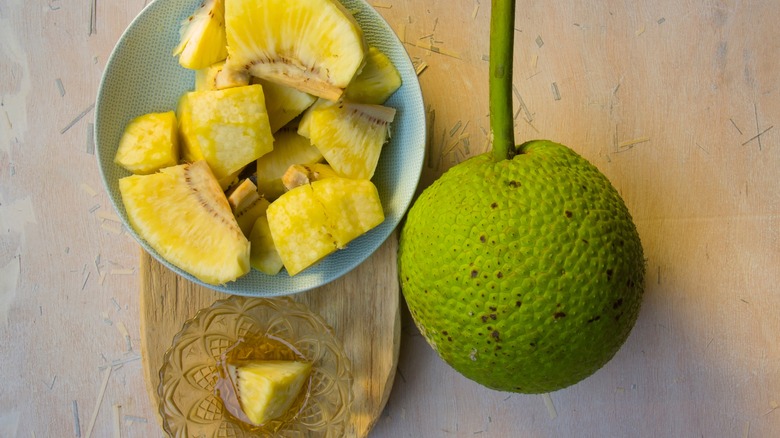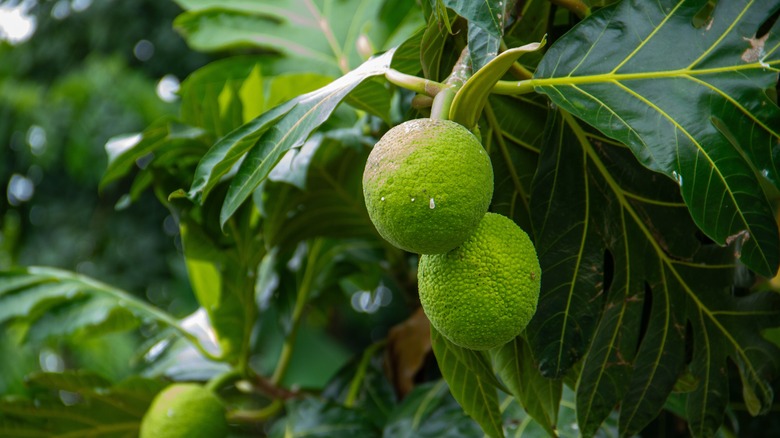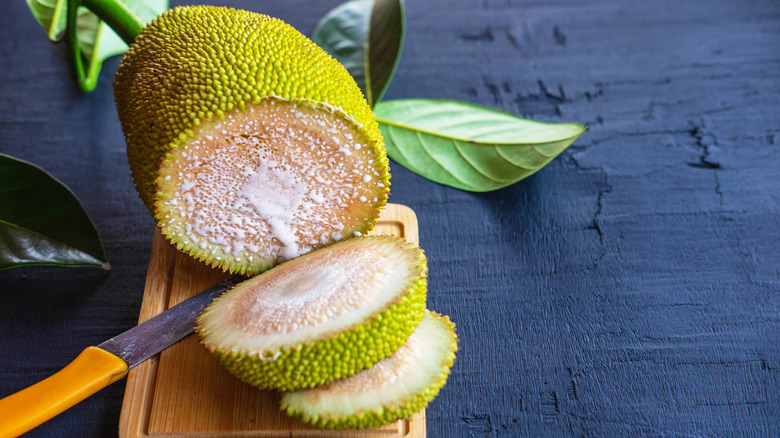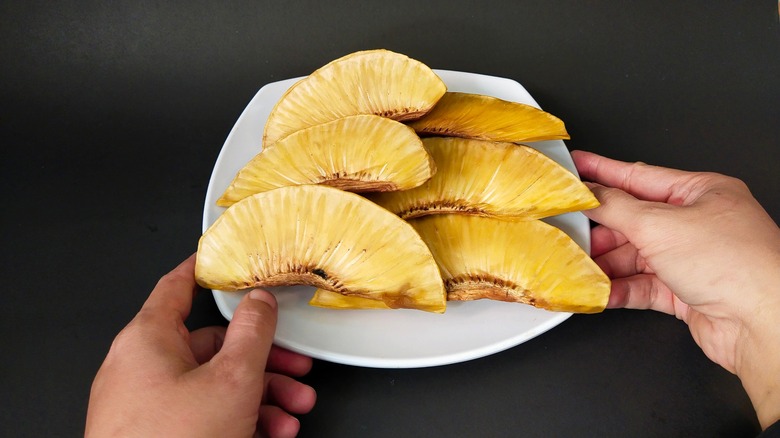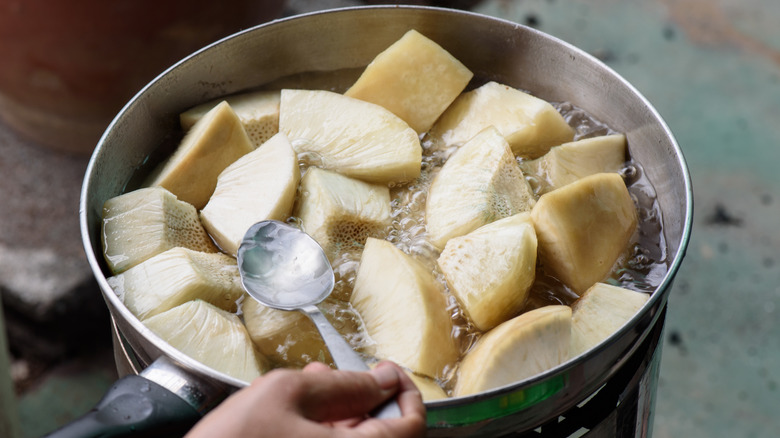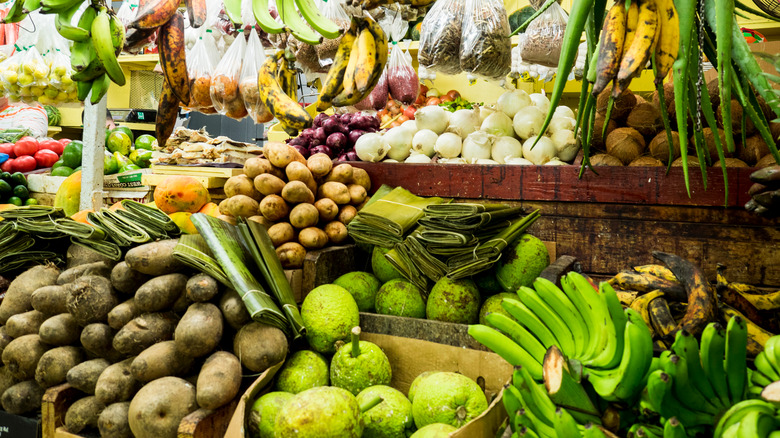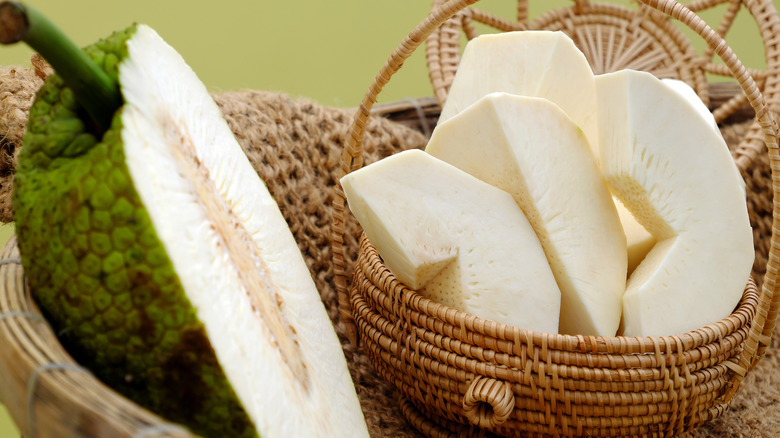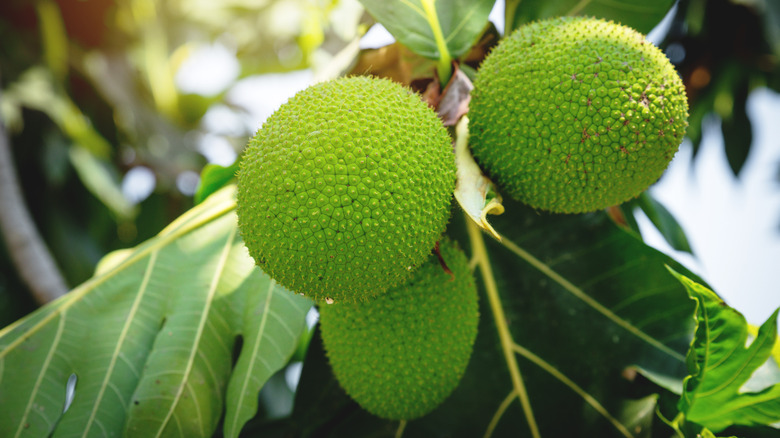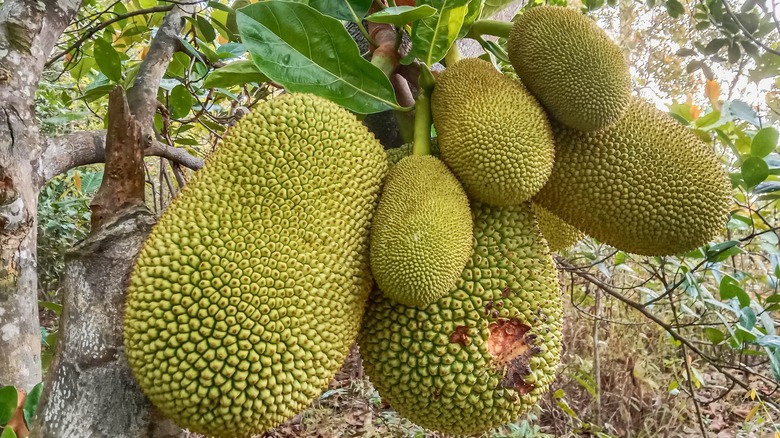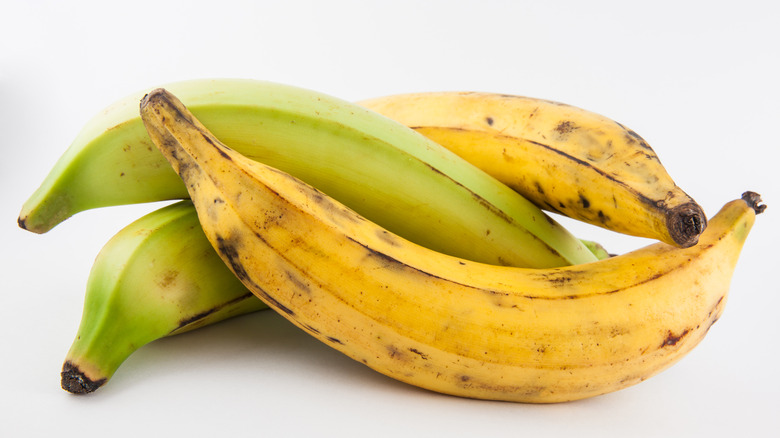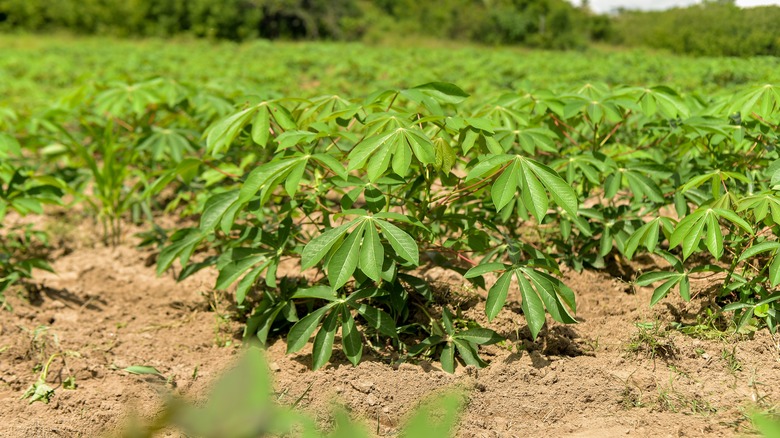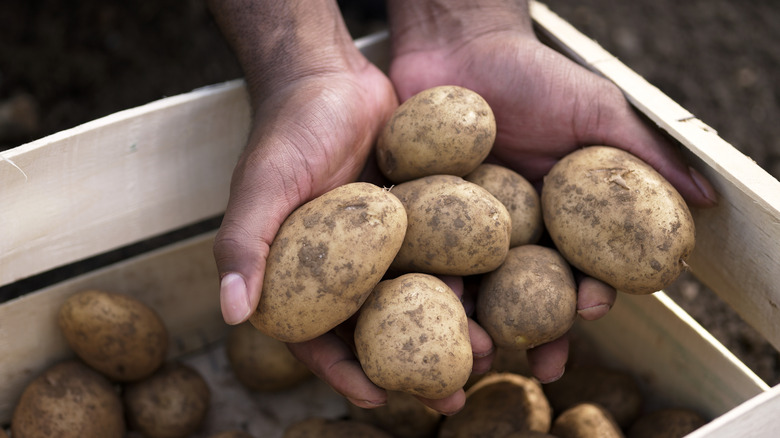Breadfruit Is The Versatile Ingredient With Similar Uses As Potatoes
If you've never heard of breadfruit, you're not alone. Although breadfruit has been a staple crop in the South Pacific for thousands of years, it's relatively unknown in the United States outside Hawai'i, where it's called 'ulu and forms part of the islands' rich cultural history.
Because of the high starch content in breadfruit, the flavor isn't that unlike a potato before it's fully ripened. Its starchy disposition also means that potatoes and breadfruit can be used for many of the same delicious preparations. Breadfruit fries, anyone? You may be surprised to find that a potato and a fruit can have so much in common, but breadfruit isn't just any fruit. Its versatility, ease of cultivation, and cultural significance in various regions make breadfruit worth learning much more about. And although breadfruit has been flying under the radar in the mainstream culinary scene in the United States, due to climate change, you could see it growing in certain parts of the country soon.
What is breadfruit?
If you don't live in a tropical climate and you're wondering what a breadfruit is, that's understandable. These starchy, green pods don't fit the typical profile of most other fruits. Before they're fully ripe, breadfruits have a natural starchiness that makes them easy to incorporate into savory meals, although they become sweeter as they mature, which then makes them perfect for desserts. Breadfruits are round and green, and their exteriors have a stippled texture. They grow to about 4-8 inches in diameter and they're filled with a fibrous, white pulp that's usually cooked before it's eaten.
Breadfruit is easy to cultivate, has a high yield of fruit, and can grow in a whole range of different environments. Some studies suggest that breadfruit could help combat global hunger if it were planted on a large scale because it's packed with calories and contains the highest amount of carbs per cup of any fruit. A 2023 article in Forbes even claimed that breadfruit could become "a global future food trend" given all of these combined qualities.
Where does breadfruit come from?
Although breadfruit is believed to be native to the Malay archipelago and New Guinea off the coast of Southeast Asia, it now grows in tropical climes all over the world. The breadfruit was brought to the Caribbean in the 18th century by William Bligh after he was famously the victim of a mutiny on the HMS Bounty. Breadfruit's history in the Caribbean is tied to the history of slavery, as it was brought initially to provide food for enslaved Africans working on British plantations in the Caribbean.
These days, breadfruit grows abundantly on the Caribbean islands, and because it is such a low-maintenance crop, it saves a whole lot of labor while providing people with an excellent source of nutrients and calories. In parts of the Caribbean, it's become so entwined with the culture that jackfish and breadfruit is known as the national dish of St. Vincent and the Grenadines. In its native South Pacific, it's often grown in home gardens, where locals pick these abundant fruits to make a whole range of delicacies.
What does breadfruit taste like?
Breadfruit's beauty is in its versatility. When it's not quite ripe, breadfruit tastes starchy and a bit savory, not unlike actual bread. Because its flavor is so mild and it has a firm, hearty texture before it fully matures, you can use unripened breadfruit in similar ways to how you'd use a potato. It has a mild, slightly nutty taste and easily takes on the flavors of whatever dish you use it in. Because of that, it's often picked to be used in curries and other flavorful, saucy dishes.
Once a breadfruit is fully ripened, it becomes softer, sweeter, and more fragrant. The texture also becomes softer and the color turns yellow, so when you open a ripe breadfruit, it's a creamy wonderland of pale yellow flesh. At this stage, it can be turned into a wide variety of delicious desserts, including mousse, pie, and pudding.
How to cook with breadfruit
If you've got a creative culinary imagination, then breadfruit is the ingredient you've been waiting for. But before you start cooking, there are some basics about breadfruit preparation that you should know. Breadfruit contains a sticky resin — especially the underripe fruits — and things can get pretty messy if you're not prepared. It's best to cut off the stem of sappy breadfruit and drain the resin. Once you cut it up, let the slices sit in water for a few minutes, then wash them.
Since these plump, green fruits grow in tropical climates all over the world, different cultures have adopted different ways of preparing breadfruit. In Indonesia, breadfruit is often sliced up and deep-fried or made into chips. In the South Pacific, one traditional preparation involves digging a pit, lining it with banana leaves, filling it with ripe, peeled, pitted breadfruit, and letting it ferment.
Breadfruit is giving potatoes a run for their money, too. In an episode of "Gordon Ramsay: Uncharted," the celebrity chef even uses breadfruit as a replacement for potatoes to make a shepherd's pie. Breadfruit is also a unique way to bulk up one-pot stews the same way you would with potatoes.
Where to buy breadfruit
Chances are you're not going to find breadfruit at your local grocery store. Although these bumpy beauties are plentiful in the tropics, it's not easy to get your hands on a fresh breadfruit at higher latitudes. Breadfruits are highly perishable, and their quality begins to deteriorate just a few days after they're harvested. Historically, there just hasn't been enough of a demand for it outside the tropics to develop an efficient, reliable supply chain like there is with bananas (another perishable tropical fruit). Even in specialty grocery stores, they're almost impossible to find.
You can, however, order them online. Grocery providers like FreshDirect sell them, as well as some smaller providers like the Hawai'i 'Ulu Cooperative. If you can settle for other breadfruit products, it's easy to buy less perishable options like breadfruit flour or breadfruit chips, which are easier to transport and store. And if that doesn't do it for you, you can always plan a vacation to a tropical country where breadfruit grows.
Nutritional information about breadfruit
There's talk about breadfruit becoming one of the next hot superfoods to consider adding to your diet. Breadfruit is a great source of complex carbohydrates, which make you feel fuller, can help regulate blood sugar, and give you energy over a longer period of time. It's also full of antioxidants – compounds that deactivate cell-damaging free radicals – and may help lower the risk of cancer, heart disease, and other harmful conditions.
When you compare it to other staple crops like corn, soybeans, and potatoes, breadfruit has a much higher amino acid content and is also a great source of minerals like magnesium, phosphorus, calcium, and zinc. Breadfruit also has a high fiber content, which promotes healthy digestion and can lower your cholesterol levels, and it's packed with omega-3 fatty acids, which contribute to good cognitive function and can help your skin appear healthy and soft. That's a lot of reasons to consider adding breadfruit to your diet.
Varieties of breadfruit
Don't get us wrong, eating breadfruit is a unique experience, but this tasty, textured food has a fair number of close genetic cousins around the world that are also worth trying. To the untrained eye, Ma'afala might look like any other breadfruit, but it's actually a unique variety that originated in Samoa and Tonga. It's softer and juicier than the average breadfruit, but it's similar enough that it can still be used in most of the same preparations.
Otea is a variety of breadfruit that hails from Polynesia. It is especially high in protein and fiber, making it a super healthy choice, and an otea breadfruit tree can thrive and produce a hefty number of fruits in soils that would be too salty for other breadfruit varieties. Another breadfruit variant, ulu fiti, comes from the Fijian islands and is distinguished by the presence of a few large seeds inside the fruit that you can't miss when you cut it open.
How to store breadfruit
If you're lucky enough to get your hands on a breadfruit, you'll want to eat it fresh. Breadfruit spoils quickly and does not travel well. If you're not feeling a hankering for it when you've got it on hand, it'll last for a few days in the refrigerator, but not much more. You should cook breadfruit as soon as you can and then store it because freezing raw breadfruit can result in an undesirable flavor once it's thawed. Once it's baked or steamed, cool it to room temperature before placing it in a freezer-safe bag, where it can last for months.
Another way to make your breadfruit last longer is to dry it, which you can do slowly in the oven or out in the sun. Once the breadfruit is properly dehydrated, store it in airtight plastic bags to lengthen the shelf life. Then enjoy it as a snack on its own, or throw it into a soup or stew. Traditionally, in the South Pacific, breadfruit has been preserved for long periods (years, even) by fermenting its pulp in a pit lined with banana leaves. And if you don't have a banana leaf-lined pit available, you can use any airtight container.
Breadfruit vs. jackfruit
Like breadfruit, jackfruit is green, oblong, has a textured surface and is native to Asia. These two fruits are not-so-distant cousins, but when it comes to taste and texture, there are some key differences. Breadfruit is starchier than jackfruit, and it's not uncommon to eat it before it's fully ripe, while jackfruit is sweeter, and its taste and texture are best enjoyed fully ripe.
Jackfruit also has large seeds on the inside that you've got to scoop to extract the flesh and enjoy it. And although breadfruit and jackfruit look quite similar, there's no mistaking the smell. When it's ripe, breadfruit smells quite mild and a bit earthy, while jackfruit is very pungent and smells almost like a combination of bananas and pineapple. Jackfruit has been the subject of significant buzz, especially from vegans and vegetarians because it's often used as a meat substitute due to its stringy texture, which loosely resembles that of pulled pork. It's primarily for this reason that jackfruit is easier to find in the United States than breadfruit. (Even Trader Joe's sells canned jackfruit.)
Breadfruit vs. plantains
It might seem strange to compare breadfruit to plantains, but on many Caribbean islands, these are both hearty staple crops and are often prepared in similar ways. You can make tostones with breadfruit in much the same way that you would with plantains, and this is a common way to enjoy both fruits in many places. (If you've never had tostones, you need to try this easy tostones and garlic sauce recipe.)
Although the appearance, taste, and texture of plantains are quite different than those of breadfruit, they are both excellent sources of complex carbohydrates, as well as vitamins and minerals. When used unripened, you can treat both similarly to how you would treat a potato. Although plantains look like bananas, they are sturdy enough to bake, fry, mash, or grill. They make a great neutral side dish for flavor-packed jerk chicken.
Breadfruit vs. cassava
Although cassava is a tuber, not a fruit, it shares a few key characteristics with breadfruit, the most significant being that both are starchy. Both cassava and breadfruit are great staples in terms of food security because they're easy to cultivate and yield a high amount of product per acre planted. Also known as manioc, yuca, and tapioca, the root is native to the tropical regions of South America.
When it comes to taste, the flavor of cassava resembles that of underripe breadfruit, and it can be used in many of the same preparations. One key difference is that for you to consume cassava, the root needs to be peeled and cooked first because it contains low levels of cyanide, while breadfruit can be consumed raw. Once it has been prepared for consumption, however, there's nothing to worry about. Both cassava and breadfruit are also often ground up and used as gluten-free substitutes for wheat flour.
Breadfruit vs. potato
Potatoes are a staple of the American diet. Native to South America, potatoes were introduced to Europe in the 16th century, and from there they made their way to North America. Throughout your lifetime, you've probably eaten countless versions of potatoes, from boiled and baked to fried. Maybe you even eat potatoes in some form daily. Breadfruit doesn't have nearly the same popular reach in the United States, but it can be prepared in much the same way as potatoes.
The high starch content in breadfruit makes it behave very similar to a potato when it's cooked, which is why it lends itself to many of the same preparations. While potatoes stay starchy, however, breadfruit changes flavor and becomes sweet as it ripens, meaning it has a much wider range of possibilities, including desserts. Potatoes, as a vegetable, don't have this kind of versatility when it comes to cooking. This makes breadfruit a truly unique ingredient.
